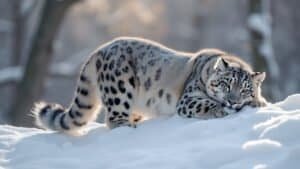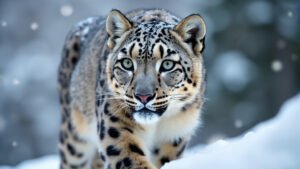Introduction
The United Nations Environment Programme (UNEP) plays a critical role in preserving endangered species, including the elusive snow leopard
As a global leader in environmental conservation, UNEP addresses key threats like poaching, habitat destruction, and climate change that jeopardize these magnificent predators. By launching targeted initiatives, promoting international collaboration, and funding conservation projects, UNEP aims to safeguard snow leopards and their ecosystems
This article explores UNEP’s impact on snow leopard conservation, its collaborative efforts with local communities, and its strategies for ensuring long-term survival of this iconic species
The Role of UNEP in Snow Leopard Conservation
The United Nations Environment Programme (UNEP) has become a key player in global efforts to conserve snow leopards, an endangered species crucial to the ecosystems of high-altitude regions
UNEP works to mitigate threats such as poaching, habitat destruction, and climate change by leading international projects, promoting policy reforms, and encouraging collaboration between nations
Below, we delve into UNEP’s wildlife protection mission, its targeted snow leopard initiatives, and the organization’s partnerships with governments and local communities
UNEP’s Wildlife Protection Mission
UNEP’s overarching mission in wildlife conservation focuses on protecting biodiversity and fostering sustainable ecosystems worldwide
For snow leopards, this involves advocating for the preservation of their fragile habitats across the mountains of Central and South Asia. UNEP addresses key threats like deforestation, climate change, and overgrazing, which degrade the snow leopard’s environment
One of UNEP’s most significant contributions is the promotion of the Convention on International Trade in Endangered Species (CITES), an international treaty ensuring that wildlife trade does not threaten species’ survival
Snow leopards benefit from CITES regulations, which ban the sale of their pelts and other body parts in international markets. UNEP also leads the High Mountain Initiative, a program aimed at protecting biodiversity in mountainous regions where snow leopards thrive
By working with global institutions and governments, UNEP sets conservation benchmarks, such as increasing snow leopard populations and safeguarding migration corridors. This includes data collection through satellite tracking and research on ecological factors impacting snow leopard survival
UNEP’s emphasis on multi-stakeholder collaboration ensures that conservation priorities are integrated into regional and national development plans
Key Snow Leopard Initiatives by UNEP
UNEP spearheads numerous projects directly aimed at snow leopard conservation. Among these is the Global Snow Leopard and Ecosystem Protection Program (GSLEP), a collaboration of 12 range countries launched with UNEP’s support
This program focuses on increasing habitat connectivity, curbing poaching, and enhancing the livelihoods of local communities to reduce human-wildlife conflict
Additionally, UNEP collaborates with organizations like the Snow Leopard Trust and Panthera to fund research initiatives and promote community-based conservation programs. These efforts include training local wildlife rangers, equipping them with tools to monitor snow leopard populations, and funding anti-poaching patrols
A groundbreaking initiative is UNEP’s Mountain Adaptation Program, which helps snow leopard habitats adapt to the challenges of climate change. By restoring degraded land and reducing livestock pressures, this program secures critical areas for snow leopards and their prey
Furthermore, UNEP’s educational campaigns aim to shift perceptions of snow leopards from a threat to livestock to a valued part of the ecosystem, promoting coexistence between humans and wildlife
Collaboration With Governments and Communities
UNEP emphasizes the importance of engaging local governments and communities in snow leopard conservation
Governments are encouraged to adopt policies that designate snow leopard habitats as protected areas, which not only conserve biodiversity but also support ecotourism, creating alternative incomes for local populations
Involving communities is central to UNEP’s strategy. Through programs like the Community Conservation Stewardship initiative, UNEP empowers locals to participate in conservation efforts
This includes providing economic incentives, such as eco-compensation schemes where communities receive payments for preserving snow leopard habitats, and offering training to mitigate livestock losses without resorting to retaliatory killings
UNEP also works to integrate traditional ecological knowledge with modern conservation practices. For instance, involving indigenous herders in monitoring snow leopard movements has proven effective in reducing conflicts
This collaboration ensures that conservation measures are sustainable and culturally respectful
How UNEP Combats Snow Leopard Threats
The survival of snow leopards is threatened by numerous factors, including poaching, habitat loss, and climate change. UNEP addresses these challenges with comprehensive strategies that combine funding, policy advocacy, and global awareness campaigns
This section explores how UNEP combats poaching, protects snow leopard habitats, and fosters global recognition of their plight
Funding and Policy Support for Anti-Poaching
Poaching remains one of the most immediate threats to snow leopards, driven by the demand for their pelts and bones on the black market. UNEP tackles this issue through both funding and policy advocacy
By supporting enforcement agencies in snow leopard range countries, UNEP provides the resources necessary for anti-poaching patrols, advanced surveillance technologies, and cross-border cooperation
UNEP plays a pivotal role in facilitating international agreements, such as the Convention on International Trade in Endangered Species (CITES). By strengthening CITES implementation, UNEP ensures that illegal trade in snow leopard products is penalized globally
Additionally, UNEP supports capacity-building programs that train local rangers and enforcement officers to track poachers and secure habitats
In collaboration with the World Bank and other partners, UNEP has funded initiatives like the Global Environment Facility (GEF), which allocates millions of dollars annually for wildlife conservation
This funding is used to enhance anti-poaching operations, develop infrastructure in protected areas, and raise awareness about the illegality and ecological consequences of poaching
The fight against poaching also includes tackling its underlying causes, such as poverty in local communities. UNEP provides economic incentives to reduce reliance on poaching, encouraging sustainable livelihoods like ecotourism or wildlife-friendly farming practices
By addressing both supply and demand, UNEP takes a holistic approach to curbing this illegal activity
Addressing Habitat Loss Through Protected Areas
Habitat loss due to infrastructure development, mining, and climate change is another critical threat to snow leopards
UNEP combats this through habitat restoration projects and the establishment of protected areas. The agency works with governments to designate and manage conservation zones where snow leopards and their prey species can thrive undisturbed
One notable initiative is UNEP’s High Mountain Initiative, which focuses on preserving biodiversity in critical high-altitude ecosystems. This program restores degraded lands, prevents deforestation, and improves water management to ensure that habitats remain viable for snow leopards and other species
Additionally, UNEP promotes the concept of ecological corridors, which connect fragmented habitats, allowing snow leopards to roam freely and maintain genetic diversity
UNEP also addresses climate change impacts on snow leopard habitats. Melting glaciers and changing weather patterns threaten the ecosystems where snow leopards reside
Through the Mountain Adaptation Program, UNEP helps communities and governments adapt to these changes by implementing sustainable land-use practices and reducing livestock overgrazing, which depletes vegetation crucial for prey species
Promoting Global Awareness and Education
A critical component of UNEP’s efforts is raising global awareness about snow leopard conservation. UNEP’s campaigns aim to educate the public, policymakers, and businesses about the ecological importance of snow leopards and the urgent need to protect them
UNEP supports annual observances like International Snow Leopard Day, which highlights the plight of this endangered species and encourages global action. Educational materials, documentaries, and media campaigns are distributed to showcase the role of snow leopards as keystone predators and the threats they face
Moreover, UNEP collaborates with educational institutions and NGOs to integrate wildlife conservation into school curricula in snow leopard range countries. These programs inspire young people to value biodiversity and participate in conservation efforts
UNEP’s global campaigns also target urban populations and industries that contribute to habitat destruction or illegal wildlife trade. By promoting ethical consumerism and corporate responsibility, UNEP encourages businesses to adopt sustainable practices that reduce their ecological footprint
Evaluating UNEP’s Conservation Impact
UNEP’s conservation initiatives have had measurable impacts on snow leopard populations, their habitats, and the local communities that coexist with them
Evaluating these efforts helps to identify successes, address ongoing challenges, and refine strategies for long-term preservation. This section examines UNEP’s monitoring techniques, highlights success stories, and discusses its future goals for snow leopard recovery
Monitoring Snow Leopard Populations and Habitats
Effective conservation requires reliable data, and UNEP invests in advanced technologies to monitor snow leopard populations and their habitats
Collaborative efforts with organizations like the Snow Leopard Trust and Panthera have introduced the use of camera traps, GPS collars, and satellite tracking to estimate population sizes and movement patterns
These monitoring tools provide critical information about snow leopard behavior, migration routes, and interactions with prey species. They also help conservationists identify high-risk areas for poaching and habitat degradation, allowing UNEP to allocate resources efficiently
For example, data collected through UNEP-supported projects have revealed declining snow leopard populations in fragmented habitats, prompting the establishment of ecological corridors to improve connectivity
Additionally, UNEP conducts periodic assessments of habitat quality using geospatial mapping and environmental impact studies. These evaluations help to measure the effectiveness of protected areas and habitat restoration projects, ensuring that conservation goals are met
Success Stories and Challenges in UNEP Programs
UNEP’s conservation programs have achieved significant milestones, particularly in fostering international collaboration
The Global Snow Leopard and Ecosystem Protection Program (GSLEP), launched with UNEP’s guidance, has united 12 range countries in a shared commitment to double snow leopard populations by 2040. This initiative has resulted in the designation of over 20 new protected areas and the development of transboundary conservation agreements
Community-based conservation projects supported by UNEP have also shown remarkable success. For instance, programs in Kyrgyzstan and Mongolia have reduced retaliatory killings by offering livestock insurance schemes and training herders in predator-friendly practices
These efforts have improved local attitudes toward snow leopards while addressing the economic challenges faced by herding communities
However, challenges remain. Poaching and illegal wildlife trade persist despite international bans, fueled by high demand for snow leopard pelts and bones. Habitat loss due to mining, infrastructure development, and climate change continues to threaten snow leopard survival
Limited funding and enforcement capacity in some range countries further hinder progress. UNEP acknowledges these obstacles and actively works to strengthen partnerships and secure additional resources for its programs
Goals for Snow Leopard Recovery
UNEP’s long-term vision for snow leopard conservation includes ambitious yet achievable goals
By 2030, UNEP aims to secure at least 50% of all snow leopard habitats under effective conservation management. This involves expanding protected areas, restoring degraded landscapes, and ensuring that critical ecological corridors are maintained
Another key objective is to reduce human-wildlife conflict through expanded community-based initiatives. UNEP plans to scale up programs like livestock insurance and predator deterrents, aiming to eliminate retaliatory killings entirely in targeted regions
UNEP is also committed to increasing global awareness of snow leopard conservation. Through continued media campaigns, educational programs, and international partnerships, UNEP seeks to build momentum for collective action against the threats snow leopards face
Lastly, UNEP prioritizes adaptive management—continuously refining its strategies based on scientific research and program evaluations. By integrating traditional ecological knowledge with cutting-edge technology, UNEP ensures that conservation efforts remain both effective and culturally sensitive
Conclusion
The United Nations Environment Programme (UNEP) has emerged as a critical force in snow leopard conservation, addressing threats such as poaching, habitat loss, and climate change through a combination of policy advocacy, international collaboration, and community engagement
UNEP’s initiatives, like the Global Snow Leopard and Ecosystem Protection Program (GSLEP) and the High Mountain Initiative, have not only established protected areas but also fostered partnerships that empower local communities to coexist with snow leopards
Despite these achievements, challenges such as illegal wildlife trade and the impacts of climate change remain significant hurdles. UNEP’s commitment to adaptive management, data-driven strategies, and sustainable development ensures that conservation efforts evolve to meet these challenges effectively
By continuing to prioritize habitat protection, global awareness, and economic incentives for local populations, UNEP works toward securing a future where snow leopards can thrive in their natural environments
As UNEP and its partners strive to meet their ambitious goals, the collective responsibility to protect these iconic predators lies with governments, organizations, and individuals worldwide
Through coordinated action and sustained commitment, the preservation of snow leopards can become a lasting conservation success story











